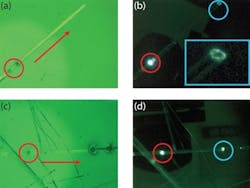Laser heating of biological microstructures shows potential for neuroscience applications
Physicists from Radboud University (Nijmegen, The Netherlands) investigated tubular biological microstructures that showed unexpected luminescence after heating—optical properties that could have utility in applications involving optical fibers and biomedical lasers, such as in neuroscience.
Related: Luminescent nanoparticle efficient and effective for PDT, cell imaging
Luminous peptide microstructures self-assemble in a water environment. After heating them with a laser, they showed luminescence in the green range of the optical spectrum.
"The optical activity in the green range was a surprise for us," says physicist Sergey Semin of Radboud University, who led the work. "According to our theories, the molecular structure of our molecules forbids them to be luminescent in that spectral range. We expect that interactions between the peptide and the water molecules might be the cause for our unexpected finding. They form a kind of 'super cell' together, which we hypothesize emits light after heating."
Semin explains that understanding the underlying mechanisms of these microstructures can give new insight in the optical properties of peptides and short organic molecules. Since the microstructures are the core recognition motif of β-amyloid fibrils that form plaques in the human brain, the team's work could have implications in studies of Alzheimer's and other brain diseases.
The recognition structures can be excited and made visible by heating them, but clinical applications are still far away, Semin says.
The research team's findings were published in the journal Small; for more information, please visit http://dx.doi.org/10.1002/smll.201401602.
-----
Don't miss Strategies in Biophotonics, a conference and exhibition dedicated to development and commercialization of bio-optics and biophotonics technologies!
Follow us on Twitter, 'like' us on Facebook, and join our group on LinkedIn
Subscribe now to BioOptics World magazine; it's free!
